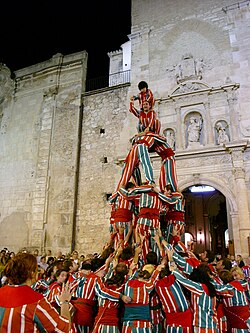
The Muixeranga ([mujʃeˈɾaŋɡa] ) is the collective name given to the performance of ancient street dances and human pyramids or castells, originating in the ancient Kingdom of Valencia (currently the Land of Valencia), which are still preserved in the town of Algemesí, 30 km (19 mi) southwest from Valencia, and certain other Valencian towns.
The muixeranga is much more than an artistic acrobatic dance. It is a collection of ancient human choreographies of enormous plasticity illustrating various figures and shapes, which are held during the Algemesí town festival (September 7 and 8th), in honor of the Virgin of Health (Mare de Déu de la Salut).
The Muixeranga resembles the modern castellers in many ways, the latter being spread all over Catalonia. Both traditions share the same origin, the "Moixiganga", (a series of dances of human towers) once found throughout the Iberian Peninsula. Muixeranga differs from castellers mainly in that the Muixeranga has a religious background and is accompanied by a traditional dance, it is also focused in the height of the human towers, but focuses also in the complexity and technique in order to create a plastic, figurative scene.
